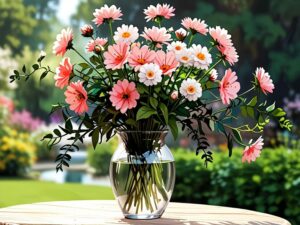beautiful:by5oj2_qmci= flowers: A Celebration of Nature’s Masterpieces

beautiful:by5oj2_qmci= flowers have a magical way of bringing joy and beauty into our lives. They are nature’s vibrant expressions, each bloom carrying its charm and story. From the subtle elegance of a delicate blossom to the bold hues of a tropical flower, the diversity of beautiful flowers is astonishing. This article will explore the enchanting world of flowers, their symbolism, cultivation tips, and the joy they spread.
The Allure of Beautiful Flowers

beautiful:by5oj2_qmci= flowers have fascinated humanity for centuries. Their colors, shapes, and scents have inspired poets, artists, and lovers alike. Every flower is a testament to nature’s creativity, showcasing a palette that ranges from soft pastels to vibrant, eye-catching hues. Whether it’s the gentle sway of a daisy in a summer breeze or the rich, velvety petals of a rose, each flower tells a unique story.
When we think of beautiful:by5oj2_qmci= flowers, some iconic names come to mind—roses, tulips, lilies, and orchids. Each has its significance and appeal. Roses, for instance, are often associated with romance and passion, while daisies evoke feelings of innocence and purity. On the other hand, orchids stand as symbols of luxury and exotic beauty, captivating anyone who lays eyes on them.
Moreover, the sensory experience that beautiful:by5oj2_qmci= flowers provide goes beyond sight. The fragrances of flowers can transport us to cherished memories or create a serene atmosphere. Imagine walking through a garden filled with the sweet scent of jasmine or lavender, where every breath feels like a gentle embrace from nature. These sensory details deepen our appreciation for beautiful flowers, reminding us of the simple pleasures they bring.
The Symbolism Behind Beautiful Flowers
Flowers carry profound meanings, often used to convey emotions that words may fail to express. The symbolism of flowers can vary widely across cultures, but many share common threads. Understanding these meanings can enhance our interactions with flowers, whether we are gifting them or simply admiring their beauty.
Take the rose, for example. Beyond being a symbol of love, different colors of roses represent various emotions. Red roses symbolize passionate love, while yellow roses convey friendship and joy. White roses often represent purity and new beginnings, making them a popular choice for weddings. By choosing the right color, we can communicate feelings that resonate deeply with both the giver and the recipient.
Another flower with rich symbolism is the lily. Often associated with purity and renewal, lilies are frequently found in celebrations and memorials alike. In Christian tradition, the Madonna Lily symbolizes the Virgin Mary, representing motherhood and innocence. This duality makes lilies versatile for various occasions, from joyful celebrations to somber remembrances.
Sunflowers, with their bright yellow petals and towering stature, symbolize adoration and loyalty. Their association with the sun gives them a cheerful disposition, making them perfect for brightening someone’s day. Whether in a garden or a bouquet, sunflowers remind us to seek light and positivity in our lives.
Cultivating Beautiful Flowers
Growing beautiful:by5oj2_qmci= flowers can be a deeply rewarding experience, whether you have a sprawling garden or a few pots on a balcony. The joy of nurturing a seed into a blooming flower connects us to nature in a special way. To create a thriving floral oasis, one must understand a few fundamental principles of cultivation.
First, consider the type of flowers best suited for your environment. Some flowers thrive in full sun, while others prefer shade. For instance, if you live in a hot climate, sunflowers, marigolds, and zinnias are excellent choices. Conversely, if your space lacks sunlight, consider shade-loving plants like impatiens or ferns. Choosing the right flowers ensures a flourishing garden that brings joy and color.
Soil health is another crucial factor in flower cultivation. Healthy soil promotes strong root growth, leading to robust blooms. Incorporating organic matter such as compost enriches the soil and enhances its structure. Regular testing of soil pH can also help you determine the best plants for your space, ensuring they thrive in their environment.
Once you’ve chosen your flowers and prepared the soil, it’s time to plant! Consider the spacing between plants, as overcrowding can lead to competition for nutrients and sunlight. Regular watering, particularly during dry spells, is essential for maintaining healthy flowers. Lastly, don’t forget to deadhead your blooms—removing spent flowers encourages new growth and prolongs the blooming period.
Designing Beautiful Flower Arrangements
Creating beautiful flower arrangements is both an art and a science. It allows for creativity and expression while adhering to basic design principles. Whether you’re decorating your home or preparing for a special occasion,beautiful:by5oj2_qmci= flowers a well-designed bouquet can leave a lasting impression.
Start by choosing a color scheme that resonates with you. Complementary colors, such as orange and blue, create a vibrant, energetic feel, while analogous colors, like pink and purple, offer a softer, more harmonious look. The color combination can set the tone for the arrangement and evoke specific feelings.
Next, think about the structure of your arrangement. Using a mix of flower heights and textures can add depth and interest. beautiful:by5oj2_qmci= flowers Start with the focal flowers, such as large blooms, and then fill in with medium and smaller flowers to create balance. Don’t shy away from incorporating greenery; foliage can provide a lush backdrop and enhance the overall aesthetic.
Choosing the right vase is just as important as selecting the flowers. A tall, narrow vase works beautifully for elegant flowers like calla lilies, while a wide, shallow bowl suits a more abundant, casual arrangement. Experimenting with different vessels can elevate your floral display and make the flowers truly shine.
The Joy of Gifting beautiful:by5oj2_qmci= flowers
There’s something inherently joyous about giving and receiving flowers. A bouquet can brighten someone’s day, express love, or simply convey appreciation. beautiful:by5oj2_qmci= flowers transcend cultural barriers, making them a universally cherished gift.
When gifting beautiful:by5oj2_qmci= flowers, it’s essential to consider the recipient’s preferences. Some people have favorite blooms or colors that resonate with them. Taking the time to choose a personalized arrangement adds an extra layer of thoughtfulness, making the gift even more meaningful.
The act of giving beautiful:by5oj2_qmci= flowers also brings joy to the giver. Selecting, arranging, and presenting flowers can be a therapeutic process, allowing for creativity and connection to nature. It’s a reminder that small acts of kindness can create a ripple effect of happiness, impacting not just the recipient but also the giver.
Incorporating beautiful:by5oj2_qmci= flowers into our daily lives can also enhance our well-being. Studies have shown that having flowers in our living spaces can elevate mood and reduce stress. A simple bouquet on a dining table or a single bloom on a desk can transform the atmosphere and make our environment feel more inviting.
Beautiful Flowers in Art and Culture
Throughout history, beautiful:by5oj2_qmci= flowers have played a vital role in art, literature, and cultural traditions. They inspire countless creative expressions, serving as symbols of beauty, love, and even transience. The representation of flowers in various mediums highlights their significance in the human experience.
In art, beautiful:by5oj2_qmci= flowers have been a popular subject for painters and sculptors alike. Artists like Claude Monet and Georgia O’Keeffe have captured the delicate beauty of flowers in their works. Monet’s vibrant depictions of his garden at Giverny invite viewers to experience the serenity and splendor of nature. Similarly, O’Keeffe’s close-up paintings of flowers reveal their intricate details, celebrating their beauty in a way that transcends the ordinary.
Literature, too, is rich with floral symbolism. Poets have often used beautiful:by5oj2_qmci= flowers as metaphors for love, beauty, and the passage of time. For instance, William Wordsworth famously wrote about daffodils, evoking feelings of joy and nostalgia. Flowers have a unique ability to resonate with readers, creating imagery that lingers long after the words are read.
Cultural traditions surrounding beautiful:by5oj2_qmci= flowers abound around the world. In many cultures, flowers are integral to festivals and ceremonies. For example, in Japan, cherry blossoms are celebrated during Hanami, a festival that honors the fleeting beauty of life. Such traditions remind us of the profound connections we share with nature and the importance of celebrating beauty in our lives.
The Sustainable Future of Beautiful Flowers
As we become more aware of environmental issues, the future of beautiful flowers is shifting towards sustainability. Many people are now seeking eco-friendly practices in flower cultivation and arrangements, recognizing the importance of protecting our planet.
One emerging trend is the rise of local beautiful:by5oj2_qmci= flowers farming. Supporting local growers reduces the carbon footprint associated with transporting flowers, fostering a more sustainable floral industry. By choosing locally sourced blooms, we not only enjoy beautiful flowers but also contribute to our communities and promote biodiversity.
Another movement gaining momentum is the use of native flowers in gardens and arrangements. Native plants are well-adapted to local ecosystems and require less water and maintenance. Incorporating these flowers not only supports local wildlife, such as pollinators but also enhances the overall health of our gardens.
Moreover, there’s a growing demand for organic beautiful:by5oj2_qmci= flowers. Many consumers are becoming more conscious of the chemicals used in traditional flower farming and are opting for pesticide-free options. This shift towards organic practices benefits both the environment and our health, ensuring that the beautiful flowers we enjoy are safe and sustainable.
Conclusion: Embracing the Beauty of Flowers
Beautiful flowers are more than just a visual delight; they are symbols of love, connection, and the wonders of nature. Their vibrant colors, enchanting scents, and rich meanings enrich our lives in countless ways. Whether through gardening, gifting, or simply admiring their beauty, flowers remind us to appreciate the world around us.
As we cultivate our understanding of beautiful flowers, we deepen our connection to nature and one another. From their symbolism in art and literature to their role in our daily lives, flowers continue to inspire and uplift us. So, let’s embrace the beauty of flowers, celebrating their presence and sharing their joy with others. After all, life is a garden, and we are all meant to bloom.




